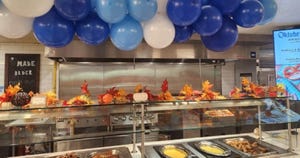The top trends impacting restaurant menus
The National Restaurant Association surveyed operators and consumers to pinpoint current culinary and dining trends.

Much of the restaurant industry was in survival mode throughout 2020, and the menu and operating trends that evolved last year were a reflection of the times. Last week, the National Restaurant Association released its 2021 Restaurant Trends Report, with survey feedback from 6,000 operators and 1,000 consumers pinpointing the top trends.
The association discovered that the pandemic accelerated some trends that were already gaining traction, such as delivery and digital ordering, and predicts that many of 2020’s innovations will be here to stay rather than passing fads.
From the operators’ survey, these 10 trends emerged:
Streamlined menus. Full-service restaurants, in particular, pared back offerings, focusing on best sellers and items that could be prepared with a reduced staff. This trend should continue into the first part of 2021.
Off-premise takes precedence. Prior to the pandemic, 80% of full-service dining took place on the premises. This quickly shifted in March, with takeout and delivery becoming the only way to generate business.
Blended meals, a team effort. Consumers did more home cooking, but still relied on restaurants for part of a meal. A dinner entree may have been made at home, but the sides and dessert ordered from a restaurant. Millennials were especially big on the blended meal.
Bundled meals? Considered deals. Individual and family meal packages composed of an appetizer, main dish and dessert, offered value and no-fuss prep to housebound consumers. These soared in popularity in 2020.
Meal kits make cooking fun. Operators made it possible for customers to prepare a restaurant meal at home, offering the components and instructions bundled in a kit. Millennials and Gen Z consumers were the biggest fans of these, with 75% in favor of purchasing a kit from a favorite restaurant.
Meal subscriptions. This is another way operators attracted customers, offering a discount on a weekly or monthly subscription of restaurant meals for takeout or delivery.
Selling groceries. Back in March and April, when supermarket shelves were often empty of essentials, restaurants started selling groceries. This petered out in summer and fall, as the supply chain readjusted to demand. But this winter, as COVID cases started spiking, restaurants are again stocking up on groceries as a convenience to customers.
Alcohol to go. One-third of 21 customers ordered beer, wine or cocktails with a delivery or takeout order. With state laws still relaxed into 2021, the association said alcohol to-go will continue to trend.
Comfort foods. There’s been a lot said about the surge in comfort foods during the pandemic, and one-third of fine-dining operators added more of these items to the menu to meet consumer demand. New additions to menus included everything from pizza to burgers, pot pies, curries and pasta dishes.
Healthy and diet-specific food. Consumers balanced out comfort food orders with more healthy choices, and gravitated toward restaurants that offered these as well. But diet-specific items, such as those labeled gluten-free or vegan, are losing traction.
The association also polled operators on their best sellers—a list that reinforces some of the trends cited above.
The top five on the full-service side are:
1. Burgers
2. Seafood
3. Pizza
4. Steak
5. Chicken (excluding wings)
The top five on the limited-service side are:
1. Sandwiches
2. Pizza
3. Burgers
4. Chicken (excluding wings)
5. Ice cream/cookies/cake
The menu trends highlighted here are excerpted from the Association’s forthcoming 2021 State of the Restaurant Industry Report, which will be released on Jan. 26.
About the Author
You May Also Like






